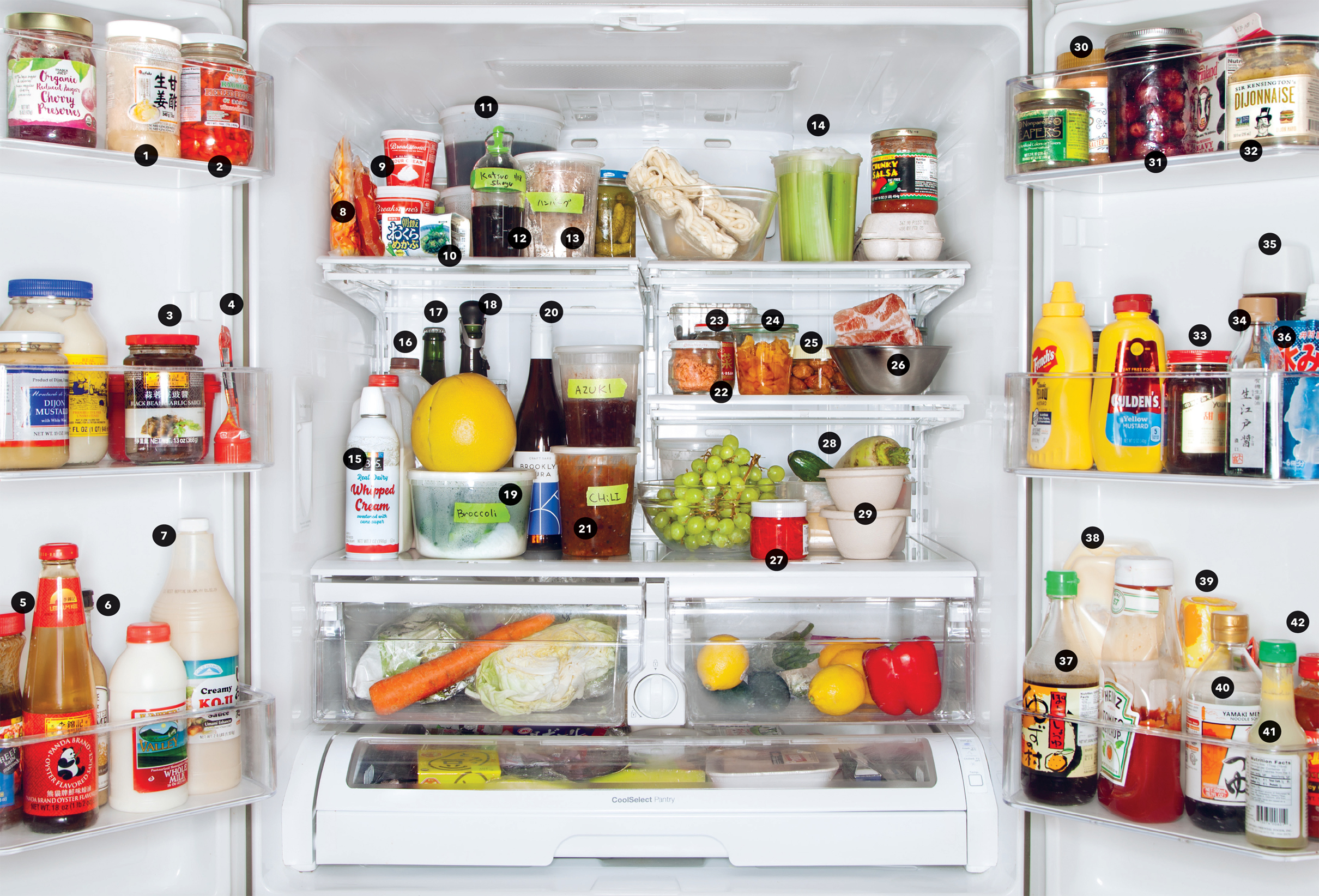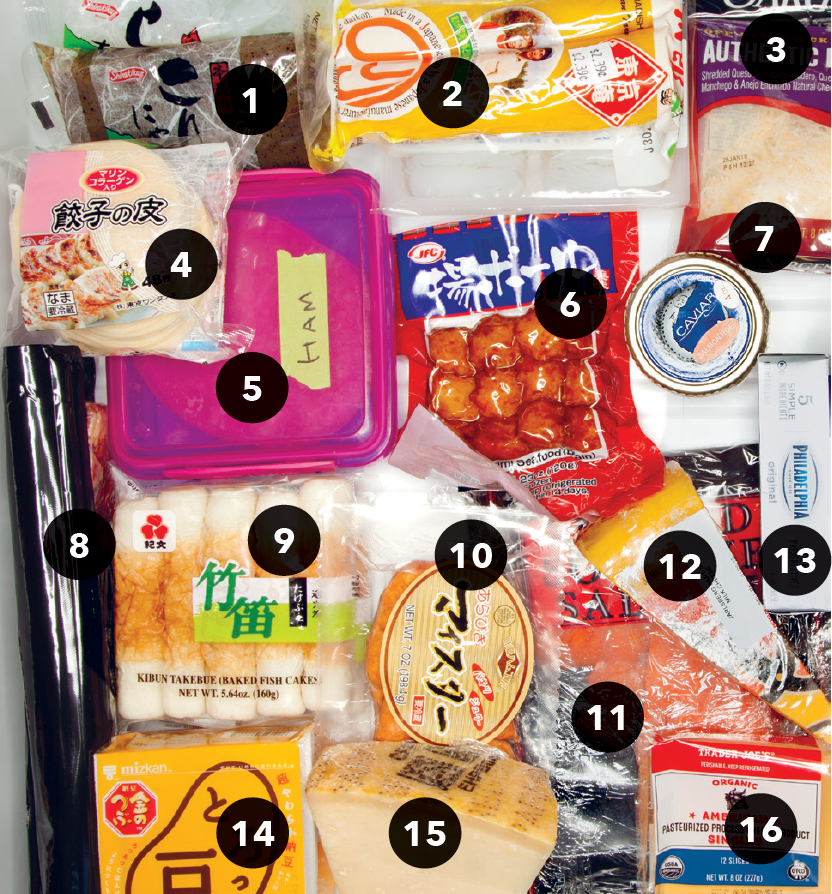
CURRENT HOMETOWN: New York City
RESTAURANT THAT MADE HIS NAME: Ivan Ramen, New York City
SIGNATURE DISH: Ramen
BEST KNOWN FOR: Being a New Yorker who opened two successful ramen shops in Tokyo; his mastery of ramen; and his cookbooks, Ivan Ramen and The Gaijin Cookbook
FRIDGE: Samsung
Ramen, dubbed the maverick cuisine of Japan, came as an epiphany and even a fluke of sorts for Ivan Orkin. While Orkin started off as a chef in New York, he eventually moved to Tokyo. There, on the brink of turning forty, he found his career coming full circle, all based on a simple idea: “With ramen I can do whatever the fuck I want.” This realization led him not only to a mastery of Japanese cooking but also to success back home.
As a child, Orkin simply wanted food that was better than the TV dinners put on the table when his parents went into Manhattan to see the ballet. Although “my mom cooked competently, she wasn’t interested in cooking. She told me she wished there was a pill she could take every morning so that she wouldn’t have to eat.” Dining out is a favorite childhood memory. “My warm feelings as a kid were very often related to food,” he says.
At age fifteen, he snapped up a weekend job at Tsubo, a Japanese restaurant that gave him his first taste of authentic Japanese cuisine: “I had only eaten at one or two Japanese restaurants with my parents before working at Tsubo,” explains Orkin. While in college he majored in Japanese and perfected his kitchen skills, cooking breakfast for his classmates in exchange for the work they did on his assignments. “I was a great student for the things that interested me, but not that many things did,” he notes. He also doesn’t look back very fondly to culinary school at the Culinary Institute of America—he credits it with teaching him how to fold in egg whites, and not much else. “I don’t think I really cooked until I worked at Lutèce and Mesa Grill,” he says now.
In 2006 Orkin opened his own restaurant in Tokyo. “It was all on me,” he says. “Day in and day out, I was in the small kitchen of my two-hundred-square-foot, ten-seat restaurant.” That gave him the discipline necessary for success. “When I opened, I was super serious—I didn’t set off to invent a mac ’n’ cheese ramen.” Yes, there was a strong Western influence in his cooking, “but it was very Japanese focused.” Instead of using premade or even fresh noodles, Orkin created his own recipe. But the raves came when he threw in some rye flour, in a nod to his hometown. His restaurant became so popular that Orkin opened another in Manhattan.
At home, just north of New York City, Orkin considers himself a homemaker in a fifty-fifty Japanese-American family. Here, where ketchup and Japanese Bull-Dog sauce have equal status, he is a little less brash, despite his three refrigerators. “I have three kids. I do a lot of cooking,” he says. Unlike their father, his children don’t enjoy going out to eat very much. “I guess it’s because we eat really well at home,” says Orkin ruefully.
The main refrigerator is spic and span. “For the Japanese, the end of the year is a cleansing time. So we start the New Year by emptying all our drawers. We throw away what we don’t use. We organize our Tupperware and throw away those that don’t have lids.”
Orkin avoids cultural clichés, though. “Even now I don’t call Ivan Ramen a Japanese restaurant, but I haven’t fallen into the trap of the matzo ball ramen or anything like that,” he says. In his opinion, that wouldn’t benefit a bowl of ramen.

- SUSHI GINGER
- PICKLED RED CHILIES
- BLACK BEAN GARLIC SAUCE
- TOMATO PASTE
- KOREAN BARBECUE PASTE
- TOASTED SESAME SALAD DRESSING—“The bottled stuff is pretty darn good. I use it on a shabu-shabu salad: thinly sliced boiled pork belly served with lettuce, tomato, and cucumber. You can make this salad really fast and everyone likes it.”
- CREAMY UMAMI SAUCE
- FUNKY CHINESE CABBAGE PICKLES— “I use them for yaki soba.”
- CURED YOLKS, from the restaurant
- VACUUM-PACKED OKRA AND SEAWEED
- SWEET BLACK BEANS—“I cook them in sugar and soy and they are good on vanilla ice cream.”
- KATSUOBUSHI SOAKED IN SOY SAUCE
- TOFU HAMBURGERS—“We are obsessed with these. This is now comfort food for me. It goes well with potato salad, and you can serve it with Bull-Dog sauce.”
- CELERY—“For my son. He is not a huge vegetable eater, but he really likes celery sticks.”
- WHIPPED CREAM, left over from a family party—“I normally make my own, but my sister brought this over.”
- CHOCOLATE MILK
- BEER
- CHAMPAGNE
- BROCCOLI—“The sure thing my ten-year-old will always eat.”
- BROOKLYN-MADE SAKE, served at the restaurant
- CHILI, left over from a football game
- SALTED SALMON, for nigiri
- JAPANESE PICKLES
- JAPANESE PICKLED MOUNTAIN VEGETABLES
- PICKLED PLUMS
- PORK BELLY
- PICKLED GINGER
- LITTLE NUBS OF VEGETABLES, to be used quickly (white radish, cucumber)
- LEFTOVERS FROM SUPERIORITY BURGER: BEETS AND RICE AND BEANS
- PEANUT BUTTER
- BLACK OLIVES
- DIJONNAISE
- MISO PASTE
- SESAME OIL
- TONKATSU SAUCE—“My liquid gold. It’s great on a hamburger or bread-crumb-coated fried shrimp, chicken, or pork.”
- BLUE CRUSHED ICE FLAVORING, from Japan—“It goes with our son’s ice shredder. He likes to make snow cones.”
- LEMON SOY SAUCE
- MAYONNAISE
- JAR OF MISCELLANEOUS TAKEOUT CONDIMENTS—“Sometimes I do a sauce where I blend all of my Asian condiments together and something good usually comes out of that.”
- YAMAKI NOODLE SOUP SAUCE WITH DRIED BONITO
- YUZU JUICE
- SPICY CHILI SAUCE

- KONNYAKU (yam jelly)
- SHIRATAKI NOODLES, for hot pot
- MEXICAN CHEESE
- GYOZA SKINS, for making dumplings
- HAM
- SEAFOOD MEATBALLS
- SALMON EGGS—“We love them and eat them all the time. They make everything better. A bowl of rice with a pile of salmon eggs and soy sauce is delightful.”
- BACON
- FISH CAKES
- CHINESE SAUSAGES
- SMOKED SALMON
- JARLSBERG CHEESE
- CREAM CHEESE
- NATTO (fermented soy beans)
- PARMESAN CHEESE
- AMERICAN CHEESE
Q & A
Your wife is Japanese and you lived in Japan for a long time. Do you eat mainly Japanese at home? If push came to shove foodwise, this is definitely a Japanese house. We don’t have bread all the time but we do always have rice.
Who cooks at home? Together with my wife we do a lot of planning. We do Sunday meal prep for the whole week: shopping, blanching, marinating. Then we have options for the week. Otherwise we find food goes in the garbage because it goes bad or you’re starving and nothing is prepped and you end up having to go out or race around. We have had a lot of success thinking a few steps ahead.
Do you shop at stores like Costco for your meal prep? I often go to Trader Joe’s and Costco. I’m not that Brooklyn guy who will only have food made by some hippie. It’s not realistic. Once a month we will go to Costco or order a bunch of meat from the restaurant. I break it down, vacuum-seal it, then freeze and label it. So there are a bunch of protein options in the freezer. We are a family of five—my kids are all boys.
Luckily you’ve got a good-size fridge. But you have two others, right? I’ve got two downstairs and a wine fridge. I have lots of beer, Champagne. I like my Champagne really cold. My wine fridge doesn’t keep it cold enough.
Wouldn’t it just be easier to have one big refrigerator, like a professional walk-in? That would be awesome. I would have one in a fucking heartbeat. You can hang meat. If you have a walk-in you can cool things on a sheet tray. You can have tall bottles. It’s about how you can store things.
Do you ever overstock? Any Japanese techniques for not overconsuming? Even a professional cook—sometimes you buy too much or something gets buried deep in. It’s disappointing when you realize it isn’t good anymore. If you haven’t used something for a number of times you should consider getting rid of it. My wife, Mari Sawamura, was basically the Marie Kondo a generation before. She is an interior decorator. She would do TV shows like that, with a before and after.
A good organizational tip for the fridge? We keep a container on the bottom shelf in which we put all the leftover little nubs of vegetables that need to be used quickly.
Guilty pleasure food? I’m in my fifties so I like to be careful what I eat. I lost a lot of weight when I gave up sweets, but an ice cream sundae with hot fudge and nuts is one of the greatest things of all time. I don’t get tired of that at all.
A quick fix for a sandwich? American cheese—it can tie together any sad sandwich and make it a good sandwich.
A rule to eat by? The rule in my life more than what I will and won’t eat is that I try to not eat while I’m doing something. If I do eat while I watch TV, read the paper, or am on a conference call, I eat lettuce or an apple. If I eat an ice cream sundae I want to be in the moment, I want to enjoy every calorie and feel like I had a great experience.